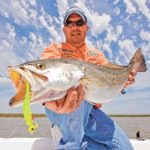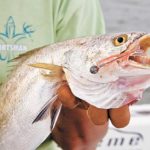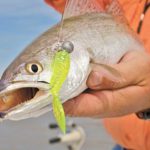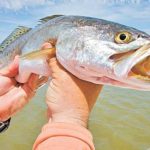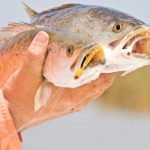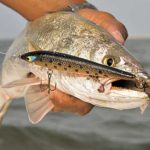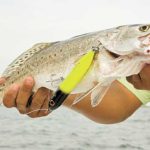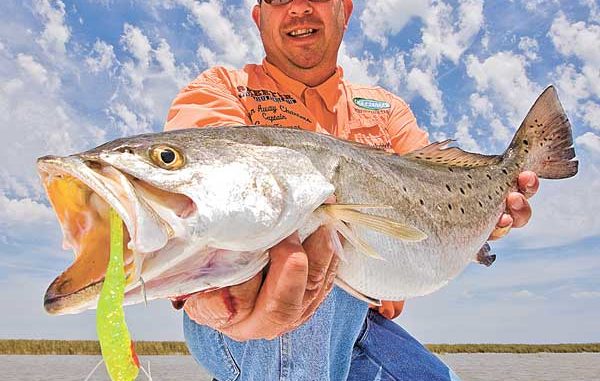
Not getting any bites on your new-fangled speck lures? Then party like it’s 1969.
Capt. Allen Welch reached toward the top of his console to retrieve a tattered sparkle beetle. It felt familiar as he threaded it onto his hook, but it had been years since he last fished one.
This was one a customer had left behind, and Welch was struggling and looking for ideas. He noticed lots of small bait — pogies, maybe shrimp — and he thought his cocaho-tail plastic may have been too big.
Within minutes of threading the chewed-up bait onto his lead-head, Welch was scrounging around for more. He found a discolored bag that held just a few baits that looked like they were poured while Jimmy Carter was still in the White House.
“We caught all our fish the rest of the day on those old sparkle beetles,” Welch recalled. “Now, every year, they’re just about all I throw at Venice from March through June.”
Farther to the west, Capt. Clark Trosclair has a stash of old Shrimp Tout Tails that he only reaches into during what he called, “those kinds of days.” He can’t find them anymore, and he treasures the remaining tails he has left.
Up the road from Venice, in the Shell Beach area, Capt. Frank Moore admits to having a Mr. Champ spoon or two stuffed somewhere in his boat’s console.
Stories like these are as plentiful along Louisiana’s coast as gnats in the marsh. We all have a soft spot in our collective hearts for baits we remember fishing as kids. The problem is that these old-school lures have been relegated to the far recesses of our minds rather than elevated to the far ends of our lines.
Maybe we should all take a clue from Welch who fished sparkle beetles as a kid, but had lost interest in them as fancier lures hit the market. Through a quirk of fate, he was reintroduced to a lure that he used to love, and rather than cast it aside again, he cast it in the water.
These are some old-school lures and techniques that Louisiana anglers are still employing today, even if they don’t talk much about them. If you’re swimming in a sea of serendipitous saltwater lures that jiggle, wiggle and do everything but catch fish, maybe it’s time you turned back the hands of time.
Sparkle beetle
“Hardly anybody buys a plastic bait that doesn’t have some kind of swimming tail on it anymore,” said Welch. “You can still find sparkle beetles here and there — I find them in the bargain bin sometimes — but I’ve been using the one that V&M makes. It’s called the Tickle Tail, and they work on the same concept, which is simplicity.”
This spring at Venice, Welch said the sparkle beetle was the only thing on which he could catch trout. His belief is that the smaller, unassuming sparkle beetle represents the smaller shrimp and baitfish that springtime fish are used to seeing and eating. Just because it’s a small bait, though, doesn’t mean it catches only small trout.
“We had an awesome day with the Tickle Tail beetles just a week ago,” Welch said in early May. “Two of us fishing, we had 50 trout with a 3- to 3 1/2-pound average, and everything was on the beetle. Our biggest was 6 pounds. I switched to a cocaho tail just to see if we could get something, but I never got a hit on it.”
Although Welch sometimes fishes tandem-rigged beetles, his primary method of fishing them is under a popping cork. The standard colors of the sparkle beetle are clear/sparkle, chartreuse and glow, but Welch adds his own favorite, which is glow/chartreuse.
Salty Grub
On most tackle shelves, you have to search to find sparkle beetles, and you have to search just a little bit harder to find the H&H Salty Grub. For some strange reason that he can’t explain, Welch has discovered that when the trout want a smoke-colored soft plastic, they also want a Salty Grub.
“When they want smoke, I switch to the Salty Grub,” he said. “Maybe it’s because they want smoke a little bit more in fall, and they’re feeding on larger shrimp and bait that time of year.
“The Salty Grub puts off a little more vibration than the beetle, and it has a different action with its spade-shaped tail. It’s also a little bit fatter, so it might do a better job imitating the larger bait that’s in the water that time of year.”
According to Welch, the Salty Grub is at its best from October through December. Since the fish are in deeper water that time of year, he typically bounces it slowly on the bottom to attract the more lethargic trout.
Shrimp Tails
The Trout Touts that Trosclair stingily hoards in a secret compartment in his boat would appear alien in nature to anglers who love throwing soft-plastic shrimp today. Rather than the entire body of the shrimp molded in plastic, the Trout Touts were nothing more than a shrimp tail with a fanned out end on it.
“I can’t find them anymore,” Trosclair said, “but there’s nothing like the ones I have left. Everybody talks about the cocaho tails and wild colors like electric chicken, but I don’t think you can beat the old white Tout Tails.”
Trosclair fishes his remaining Tout Tails slowly and on the bottom, and he considers them to be great plastics for tandem-rigging and bringing in southern Terrebonne Parish trout two at a time.
There is even a special head called a Tout Jighead, which is a gumdrop-looking jighead that fits flush against the flat head of a shrimp-tail plastic.
Although an exhaustive search didn’t turn up any Trout Touts today, there are some similar offerings still available today that offer the same action. FoodSource Lures makes a 3-inch shrimp tail. H&H has its own shrimp tail. And Deadly Dudley has its own line of shrimp tails called Mauler Shrimp.
Mr. Champ spoon
Better known for enticing big bull reds, the Mr. Champ spoon was responsible for fooling a trout or two during some of Moore’s earliest surf-fishing trips out in Breton Sound. This 3/4-ounce chunk of metal seemed to be designed with the surf angler in mind because, “You could cast them a mile,” Moore said.
Moore remembered the old Mr. Champ spoon with a yellow, stringy skirt of sorts, and once June rolled around, it was the first lure he tied on. Recalling how he used to use a 50-foot stringer to keep the sharks away from his legs, Moore explained how he fished the Mr. Champ.
“It was wild in those days,” he said. “We would get fish on those things that would try to run from a shark by swimming between your legs. We spent the weekends on the islands, and we caught a lot of fish on the Mr. Champ by casting it as far as we could and reeling it in while bouncing it off the bottom.”
Although he doesn’t hear a lot about it today, Moore believes lots of anglers are keeping the Mr. Champ tradition alive by continuing to fish it today. You can find the Mr. Champ, minus the yellow skirting, on the shelves at Academy along with all the other spoons.
Rattlin’ Rogue
“Since I’m old, I have an old-school trout lure for you,” said Capt. Owen Langridge after wrapping up a trip at Venice. “Years ago, I was an avid bass fisherman. Occasionally, I would go to the Leeville area for trout and reds. Me and my buddies discovered that one of our favorite bass lures was also deadly on specks and reds — the Rogue.”
Langridge discovered that not just any old Rogue would work. He figured out that old gold Rogue with a black back and black dots on the sides was a killer. The normal “dotted” Rogue had 12 dots on each side, but Langridge says that maybe one out of one thousand stayed in the paint room too long, and they wound up with 13 dots.
“Naturally, we called this a “thirteen-dot” Rogue,” Langridge recalled. “We used to go to Fred Parnell’s or Steinburg’s in Baton Rouge and take all the dotted Rogues off the racks and try to find the ones that had 13 dots. If it didn’t have 13, we wouldn’t buy it.”
Superstitions aside, Langridge worked the Rogue either on the surface or just below to attract trout and redfish. Although this model Rogue isn’t made anymore, Langridge says there is a gold one with a black back and one dot — a perfect job for a Magic Marker.
Goin’ Jessie
The Goin’ Jessie was a small minnow-imitating lure that was typically used as a trailing teaser lure behind a topwater plug. Since they’re nearly impossible to find today, Capt. John L. Taylor uses a modified Goin’ Jessie rig using a modern topwater plug and either a small jig or large fly.
“I remove the rear hooks on a Rattlin’ Chug Bug, and tie on about a foot of monofilament,” Taylor said. “Then I tie on the little jig or fly to the end of that line. That little lure following the topwater definitely attracts bites, and sometimes when the little schoolies take the small bait there is a big trout close by that will hit the big Chug Bug.”
Welch also uses a rig like this when he’s getting a lot of lookers but very few takers when throwing topwaters. More often than not, he reaches into his fly box and gets out a white or chartreuse/white Clouser that he uses as the trailing lure behind his topwater.
“I like to use at least 20-pound-test line for this,” Welch added. “Anything less than that is too limp, and you wind up with it wrapping around your hooks. Heavier line is stiffer, and that helps keep the fly back behind the topwater where it belongs.”
Welch says the key to catching fish on the trailing fly is to keep working the bait after a missed strike on your topwater. They’ll often nail the fly more aggressively than they did the topwater, and Welch believes his topwater actually acts much like a popping cork in this situation.
Modern advancements in fishing lures have undoubtedly made more anglers equal in the eyes of the fish, but during those times when you just can’t seem to buy a bite, you can do yourself a favor by turning back the hands of time.
Do the rest of us a favor, though, and leave your one-piece polyester jumpsuit and Peterbuilt cap at home. No need to go THAT old school.
Contact Capt. Allen Welch at (601) 799-0110, Capt. Clark Trosclair at (985) 563-2531, Capt. Frank Moore at (504) 881-9966, Capt. Owen Langridge at (225) 978-1136 and Capt. John L. Taylor at (985) 397-4383.
